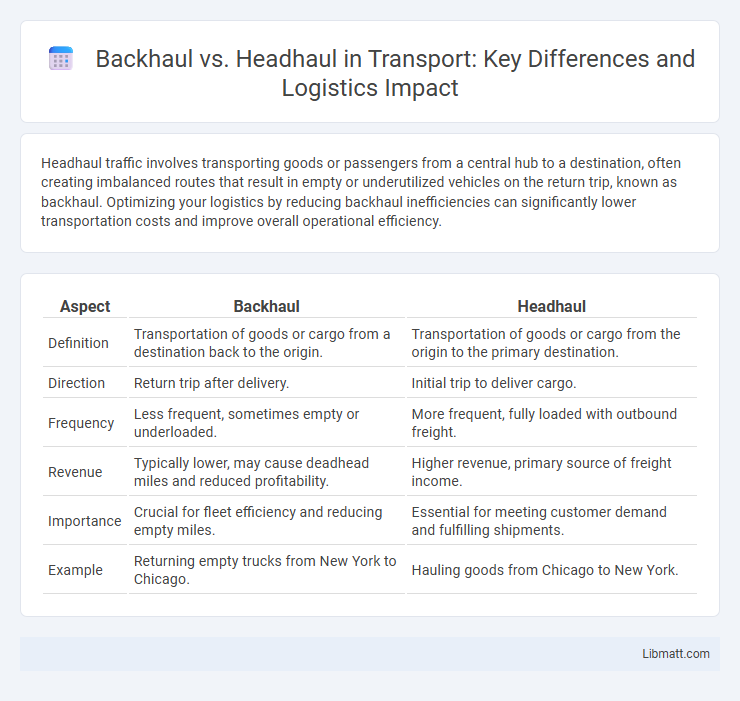Headhaul traffic involves transporting goods or passengers from a central hub to a destination, often creating imbalanced routes that result in empty or underutilized vehicles on the return trip, known as backhaul. Optimizing your logistics by reducing backhaul inefficiencies can significantly lower transportation costs and improve overall operational efficiency.
Table of Comparison
| Aspect | Backhaul | Headhaul |
|---|---|---|
| Definition | Transportation of goods or cargo from a destination back to the origin. | Transportation of goods or cargo from the origin to the primary destination. |
| Direction | Return trip after delivery. | Initial trip to deliver cargo. |
| Frequency | Less frequent, sometimes empty or underloaded. | More frequent, fully loaded with outbound freight. |
| Revenue | Typically lower, may cause deadhead miles and reduced profitability. | Higher revenue, primary source of freight income. |
| Importance | Crucial for fleet efficiency and reducing empty miles. | Essential for meeting customer demand and fulfilling shipments. |
| Example | Returning empty trucks from New York to Chicago. | Hauling goods from Chicago to New York. |
Understanding Backhaul and Headhaul: Key Definitions
Backhaul refers to the transportation of empty or lightly loaded vehicles from a drop-off point back to a pickup location, often resulting in lower revenue for carriers. Headhaul denotes the primary freight route where trucks transport fully loaded cargo, generating the highest revenue due to demand for goods movement. Understanding these terms is crucial for optimizing logistics efficiency and balancing fleet utilization in the transportation industry.
The Logistics Behind Headhaul and Backhaul Routes
Backhaul routes in logistics refer to the return trip of a transport vehicle, often carrying goods back to the origin point after completing a primary delivery, which helps maximize efficiency by reducing empty miles. Headhaul routes involve transporting goods from a main production area or distribution center to market locations, typically generating higher revenue due to heavier or prioritized cargo. Optimizing both headhaul and backhaul routes is essential for balancing supply chain costs, improving fleet utilization, and minimizing overall transportation expenses.
Economic Implications of Headhaul vs Backhaul
Economic implications of headhaul versus backhaul significantly impact transportation and logistics profitability, as headhaul routes involve transporting high-demand freight from origin to destination, generating higher revenue due to premium rates and consistent cargo loads. Backhaul routes, often characterized by return trips with lower freight demand, present cost-saving opportunities by reducing empty miles but may require strategic pricing and route optimization to maintain profitability. Efficient balancing of headhaul and backhaul volumes is critical for companies aiming to maximize asset utilization and minimize operational costs in freight transportation.
Freight Pricing: Backhaul vs Headhaul Dynamics
Freight pricing is heavily influenced by the backhaul and headhaul dynamics, where headhaul routes--typically transporting goods from major production hubs to consumption areas--demand higher rates due to greater freight volume and capacity utilization. Backhaul routes, on the return trip, often face lower demand and excess capacity, leading to discounted pricing opportunities to optimize revenue and reduce empty miles. Understanding your freight's direction relative to these dynamics can help you negotiate better rates and improve overall supply chain efficiency.
Carrier Strategies for Balancing Backhaul and Headhaul Loads
Carrier strategies for balancing backhaul and headhaul loads focus on optimizing network efficiency and reducing operational costs. Dynamic routing algorithms and predictive analytics are employed to identify volume imbalances, allowing carriers to reroute freight or adjust pricing incentives. Leveraging real-time data from transportation management systems enhances decision-making, ensuring trucks remain utilized and empty miles are minimized.
Impact on Supply Chain Efficiency
Backhaul and headhaul significantly impact supply chain efficiency by determining the balance of freight movement and reducing empty return trips. Optimizing backhaul routes enhances asset utilization and lowers transportation costs, directly improving delivery speed and reliability. Your supply chain can achieve greater sustainability and cost-effectiveness by strategically managing backhaul and headhaul logistics.
Technology’s Role in Optimizing Haul Routes
Technology plays a critical role in optimizing both backhaul and headhaul routes by leveraging advanced algorithms and real-time data analytics to balance freight loads efficiently. GPS tracking, IoT sensors, and AI-powered route optimization software reduce empty miles by matching available headhaul demand with backhaul capacity, enhancing fuel efficiency and lowering operational costs. Integration of telematics and machine learning further refines scheduling and load planning, boosting overall supply chain productivity and sustainability.
Environmental Considerations: Reducing Empty Miles
Backhaul and headhaul strategies play a critical role in minimizing empty miles, directly impacting transportation-related carbon emissions. Efficiently matching backhaul opportunities with headhaul shipments reduces fuel consumption and lowers greenhouse gas emissions by maximizing truck utilization. Optimizing these logistics pathways supports sustainable supply chain operations and decreases the environmental footprint of freight transportation.
Challenges and Solutions in Managing Backhaul and Headhaul
Managing backhaul and headhaul operations presents challenges such as imbalanced freight flow causing empty miles and increased operating costs. Effective solutions include dynamic routing algorithms, load-matching technologies, and leveraging real-time data analytics to optimize asset utilization and reduce deadhead travel. Implementing collaborative transportation management systems enhances coordination between shippers and carriers, improving overall efficiency in backhaul and headhaul logistics.
Future Trends in Haulage Logistics
Future trends in haulage logistics emphasize the optimization of backhaul and headhaul routes to reduce empty miles and enhance sustainability. Advanced data analytics and AI-driven logistics platforms enable real-time matching of freight loads, improving efficiency for both backhaul and headhaul trips. Investments in electric and autonomous vehicles combined with integrated supply chain management promise significant cost reductions and environmental benefits in haulage operations.
backhaul vs headhaul Infographic

 libmatt.com
libmatt.com